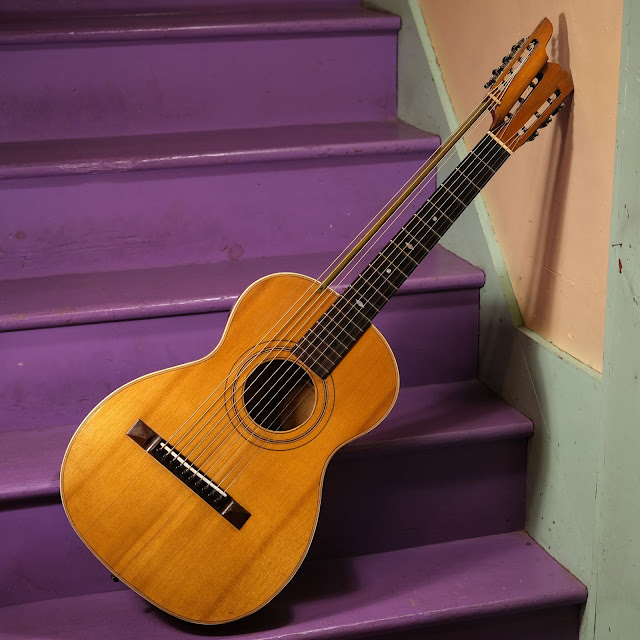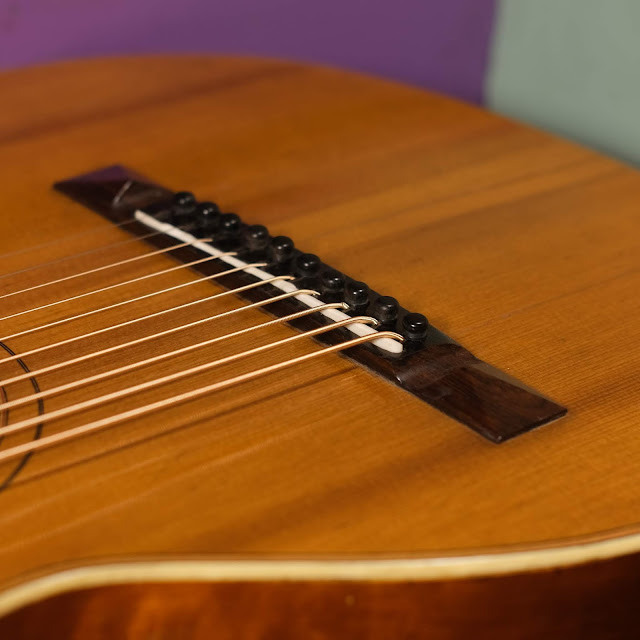1905 Levin Model 122 Harp Guitar
To top-off the recent explosion of Levin-made guitars gracing the shop, I now present this beautiful beast. Local Levin collector Ted has apparently been hiding this from me for years. At least -- that's how one feels when one fixes crazy old guitars and doesn't know a resident harp guitar that's been living right in town. Per its serial number it was built in 1905 and the earliest known example of this model from the Swedish maker.
It's also here on consignment from him and came to me in particularly good shape considering its age and type. Harp guitars are usually basket-cases when they arrive here due to all that tension. This one clearly had some old work done to it but it didn't need much surgery to make it a player.
So -- let's dispense with the pleasantries. This guy is a 000-size (~15" lower bout) 12-fret guitar with a long scale (25 1/2" -- very long for the time) and a "harp neck" extension that allows for four sub-bass strings. It was clearly meant to be played in classical fashion (more "upright") as the harp neck's brass-pipe reinforcement and strings are aligned pretty close to the fretted neck and will get in the way of thumb-overs. Folks who don't thumb-over won't care, but 3-fingers-me uses them a lot in standard tuning so I do notice when I play in standard tuning as I like that thumb for my interpretation of barred chords.
All that said, after I finished all the necessary work and got it setup and humming, I think I lost about an hour of my time due to simple fascination. This box is fun! I strung it with 50w-11 gauges on the fretted neck, tuned to standard. I used fairly heavy sub-bass strings that yielded me GACD notes low to high -- with the D just a full step below the low E. Of course, one can retune them as fit, but this setup allowed easy "folksy" playing of low bass notes in the keys of G, D, and C modal. An easy retune to FGCD on the harp strings will get you into C, D, and G modal, too. You get the picture...
The top is "A-frame-braced" with an inverted V-shaped bracing style (two long, scalloped, angled tonebars) and thinner ladder braces that cross them. This gives a sustained, clean, and clear tone to the guitar that really responds to fingerpicking (bare or not) well and takes a flatpick pretty well. It's not as warm and round as something like a Knutsen or Larson design, but it's much, much more stable. It's also not as awkward as the body shape is more traditional than many harp guitars.
Repairs included: recut of the bridge's center section to fit two new (compensated) bone saddles and fix bad worn-in string slots, cutting of those new saddles, new ebony bridge pins, a fret level/dress, side-dots install, reglue of one loose back brace, cleaning, and setup.
Setup notes: it has a straight neck and plays perfectly with 3/32" bass and 1/16" treble action at the 12th fret. String gauges are 50w, 38w, 28w, 22w, 15, 11 on the fretted neck and 76w, 72w, 64w, 60w on the harp/sub-bass neck.
Scale length: 25 1/2"
Nut width: 1 7/8"
String spacing at nut: 1 5/8"
String spacing at bridge: 2 3/8"
Body length: 20 1/4"
Lower bout width: 14 7/8"
Waist width: 9 1/8"
Upper bout width: 10 3/4"
Side depth at endpin: 4 1/4"
Top wood: solid spruce
Back/sides wood: solid birch
Neck wood: maple or similar?
Bracing type: tonebar (V/A-frame layout) with ladder braces
Fretboard: rosewood, bone nut
Bridge: rosewood, two bone saddles (drop-in for easy height adjustment)
Neck feel: medium comfy V, flat board
Condition notes: old repairs include cleats/fill to two hairline cracks on the top below the bridge, a previous neck reset job, and a back-off/back-on job at some point. The seams are a little mucked on the back edges but solidly-glued. They're not ugly. There's also an old-repair tight hairline crack on the upper bout top where the harp's brass pipe meets the body. The back center-seam can be felt/is a hair open but is secure and "cleated" its whole length via the back lining inside the body.
I'm pretty sure the original nuts have been replaced at some point with newer bone ones. The bridge is original but is discolored darker in the center from where I had to sand it and modify it to get proper saddles in place (it had an uncompensated fret saddle before -- a nightmare for intonation and good setup). I did respray it with finish and "aged" the new finish to ape the look of the original finish on it, though.
The rest of the finish looks all-original and is in good order but with the usual average usewear/playwear throughout. The tuners on the fretted neck are original and in good order but the harp neck tuners are vintage (1920s) replacements.

























Comments